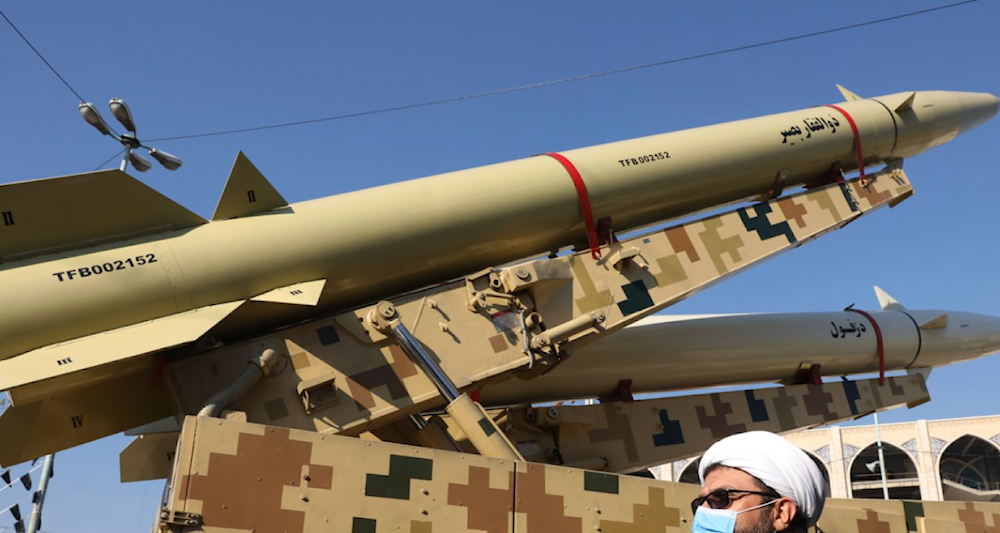Iran only non-nuclear nation to have such ballistic missile capability
Iranian ballistic missiles can reach targets 2,000 kilometers away.
-

A cleric walks past Zolfaghar and Dezful missiles displayed at Imam Khomeini mosque in Tehran on January 7, 2022. (AP)
In 2022, General Kenneth McKenzie, Commander of the Central Command (CENTCOM), believed that the Iranian military possessed about 3,000 ballistic missiles of various varieties.
On January 28, the CENTCOM announced that three US soldiers had been killed, while at least 25 had been injured in northeastern Jordan near the Syrian border.
In turn, US President Joe Biden had condemned the attack calling it "wholly unjust", reducing the event to the killing of US soldiers and making no mention of their missions overseas or the escalating tensions in the regions.
Biden blamed "radical Iran-backed militant groups operating in Syria and Iraq," likely referring to the Islamic Resistance in Iraq, which announced earlier they would escalate their attacks after the US conducted several raids in Iraq and assassinated a military official in central Baghdad.
Iran categorically rejected the claims, reiterating over and over again that the Resistance groups across the region act independently.
However, according to The National Interest, if the US continues escalating tensions in the region, it may get a taste of Iran's "expansive and capable" missiles.
Iranian ballistic missiles can reach targets up to 2,000 kilometers (1,300 miles) distant. It is the only country that has developed such a powerful ballistic missile capacity without possessing nuclear weapons.
Iranian ballistic missiles may attack huge US sites in the region and their arsenal consists of two kinds of missiles, while it is developing a third, forecasted to be the most powerful.
Iran's ballistic missile capabilities are mostly comprised of short-range ballistic missiles (SRBMs), which have a range of less than 500 kilometers (310 miles). The majority are adaptations of the Soviet SCUD tactical ballistic missiles. Tehran has also built its own SRBMs, such as the Shahab-1/2, Qiam, and Fateh-110.
The Iranian missile arsenal relies heavily on Medium-Range Ballistic Missiles (MRBMs). These missiles have a range of up to 1,300 miles and can hit any target in the Middle East or Eastern Europe.
Tehran has also been for decades developing Intercontinental Ballistic Missile (ICBM) capabilities that could reach Europe and maybe the United States.
In mid-January, "Israel's" Kan TV correspondent commented on Iran's ballistic missile launch that targeted northwestern Syria, saying the missiles "covered a distance of 1,200 km."
Elsewhere, the correspondent noted that this was "an unprecedented event," while Israeli media stated that this was the first time that an Iran-launched missile covered such a great distance, with some saying it mimicked the distance to "Tel Aviv".
The Islamic Revolution Guard Corps in Iran announced it targeted "the headquarters of terrorist groups in the region with ballistic missiles." According to the IRGC statement, the attack came in response to "the terrorist crimes recently committed by Iran’s enemies."
"Iran has announced to the world – and specifically to Israel – that it’s willing to enter the fray itself when pushed," Bloomberg highlighted in one of its reports at the time.
Kheibar-Shekan
The weapon in question is the Kheibar-Shekan, a precise-guided ballistic missile that can reportedly be maneuvered during the re-entry phase. Several missiles were used in what marked the IRGC's longest-range missile attack.
Specifications, including its ability to maneuver during re-entry or the final stage, are what award the Kheibar-Shekan missile the ability to evade air defense systems, accurately hitting ground targets.
"It’s probably the most sophisticated missile they have with the range to strike Israel," Fabian Hinz, a research fellow at the International Institute for Strategic Studies think tank, told Bloomberg.
Hinz's remarks shed light on the strides that the Iranian missile program has taken forward in recent years, however, the expert failed to take note of several other missiles, including the Fattah family of missiles. The Fattah 1 and Fattah 2 missiles both garner hypersonic capabilities, are more highly maneuverable, and have bypassed the 1,400 km range.
#Iran recently unveiled its first hypersonic ballistic missile, named Fattah, which is capable of bypassing advanced air defense systems.
— Al Mayadeen English (@MayadeenEnglish) June 6, 2023
Here's what you need to know about the highly-developed missile. pic.twitter.com/8IF1tKyYtW

 4 Min Read
4 Min Read








